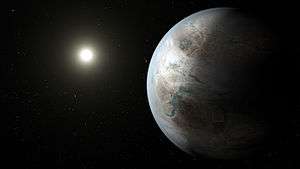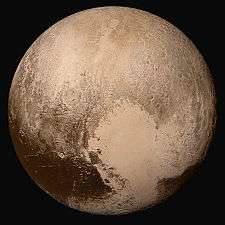EPIC 2037 b
| Exoplanet | List of exoplanets
| |||||
|---|---|---|---|---|---|---|
| Parent star | ||||||
| Star | EPIC 2037 | |||||
| Right ascension | (α) | 16:10:18.0[1] | ||||
| Declination | (δ) | -24:59:25[1] | ||||
| Distance | 590.343±55.4466 ly (181.0 (± 17.0)[1] pc) | |||||
| Mass | (m) | 1.12 (± 0.05)[1] M☉ | ||||
| Radius | (r) | 1.21 (± 0.11)[1] R☉ | ||||
| Temperature | (T) | 5743.0 (± 60.0)[1] K | ||||
| Metallicity | [Fe/H] | 0.42 (± 0.04)[1] | ||||
| Age | 5.0 (± 1.8)[1] Gyr | |||||
| Physical characteristics | ||||||
| Mass | (m) | 0.0661 (± 0.017) [1] MJ (22.34±5.4[1] M⊕) | ||||
| Radius | (r) | 0.507 (± 0.05)[1] RJ (5.577±0.55[1] R⊕) | ||||
| Density | (ρ) | 0.7103[2] g cm−3 | ||||
| Temperature | (T) | 767 K (494 °C; 921 °F) | ||||
| Orbital elements | ||||||
| Semi-major axis | (a) | 0.0775[1] AU | ||||
| Eccentricity | (e) | 0[1] | ||||
| Orbital period | (P) | 20.8851 (± 0.0003)[1] d | ||||
| Inclination | (i) | [1]° | ||||
| Discovery information | ||||||
| Discovery date | Nov. 17, 2015 | |||||
| Discoverer(s) | PETIGURA E., HOWARD A., LOPEZ E., DECK K., FULTON B. et al.[1][3] | |||||
| Discovery method | Transit | |||||
| Discovery site | Kepler Space Observatory | |||||
| Discovery status | Confirmed | |||||
EPIC 2037 b[1] also known as EPIC 203771098 b is an exoplanet orbiting the Sun-like star EPIC 203771098 every 21 days. It has about the same density as Saturn, at 0.7103 g/cm3,[3] which indicates that the planet is clearly a gas giant.
References
- 1 2 3 4 5 6 7 8 9 10 11 12 13 14 15 16 17 18 "Planet EPIC 2037 b". exoplanet.eu. Retrieved 2015-10-17.
- ↑ "HEC: Exoplanets Calculator - Planetary Habitability Laboratory @ UPR Arecibo". phl.upr.edu. Retrieved 2015-11-23.
- 1 2 Petigura, Erik A.; et al. (14 November 2015). "Two Transiting Low Density Sub-Saturns from K2". arXiv:1511.04497
 . Bibcode:2015arXiv151104497P.
. Bibcode:2015arXiv151104497P.
This article is issued from Wikipedia - version of the 10/27/2016. The text is available under the Creative Commons Attribution/Share Alike but additional terms may apply for the media files.




